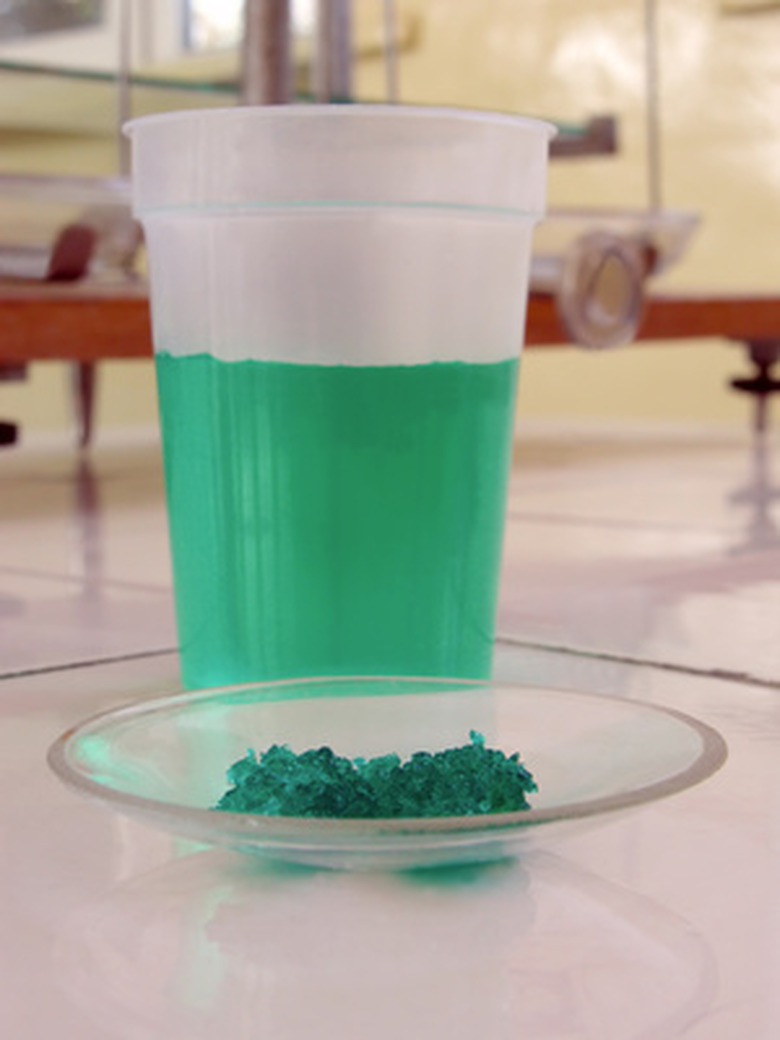How To Calculate An Ionic Strength Of A Buffer Solution
A buffer solution is a solution that is able to resist pH change after the addition of acid or base. Buffers are made by mixing large amounts of weak acids or bases together along with its conjugate. These solutions are important for many chemical applications, especially applications that are sensitive to pH changes such as biological systems. Typically, it is more important to determine the ionic strength of a buffer solution rather than the buffer's concentration. Determining ionic strength accurately defines pH of solutions by estimating concentrations of all ions in the solution.
Buffer Preparation Tips
Step 1
Create a buffer solution by picking compounds that have a pKa (acid dissociation constant) close to the pH desired for a working solution.
Step 2
Pick a buffer with a pKa lower than the working pH if the pH is suppose to decrease during the experiment.
Step 3
Pick a buffer with a pKa higher than the working pH if the pH is suppose to increase during the experiment.
Step 4
Use this formula to determine Ka: Ka=([H+][B-])/[HB]. B is the conjugate base of the acid HB.
Step 5
Now solve for pKa. The formula is: pKa= -Log10(Ka)
Ionic Strength
Step 1
Use this formula to calculate ionic strength: I=1/2 ∑ Ci Zi^2
Step 2
Let "I" equal ionic strength of the solution. The formula in Step 1 states that ionic strength is a squared sum of concentrations and valences of all ions in the solution.
Step 3
Allow the molar concentration of ions to be represented by "C." In mixed solutions, there will be several concentrations to sum. The unit is moles per liter for all ions.
Step 4
Represent the ion with "i." This could be sodium, chloride, etc. For example, there will be two "Ci" for the concentration of sodium in sodium chloride and the concentration of chloride in sodium chloride.
Step 5
Symbolize the valence or the oxidation number of the ions with Z. This is also known as the electrical charge of the ion. Again, the "i" indicates the ion.
Step 6
Square the valences on ions.
Step 7
Sum the concentrations and valences.
Example for Ionic Strength
Step 1
Determine the ionic strength of 1.0 M sodium chloride (NaCl) solution.
Step 2
List the concentrations and valences to reduce confusion. Therefore, Na+= 1.0M and Cl-= 1.0M
Step 3
Input this information into the formula and solve. For example:
I (ionic strength)= ½ (1_1 (squared)+ (1_1 (squared))
I=1
Things Needed
- Chemical compounds (i.e. sodium chloride)
- Concentration of compounds
- Valences of compounds
- Scientific calculator
TL;DR (Too Long; Didn't Read)
A general knowledge in chemistry is useful. Listing all concentrations and valences out first will help when solving the ionic strength equation.
Warning
Always consider all solutions as hazardous.
References
Cite This Article
MLA
Stanley, Nina. "How To Calculate An Ionic Strength Of A Buffer Solution" sciencing.com, https://www.sciencing.com/calculate-ionic-strength-buffer-solution-7728381/. 24 April 2017.
APA
Stanley, Nina. (2017, April 24). How To Calculate An Ionic Strength Of A Buffer Solution. sciencing.com. Retrieved from https://www.sciencing.com/calculate-ionic-strength-buffer-solution-7728381/
Chicago
Stanley, Nina. How To Calculate An Ionic Strength Of A Buffer Solution last modified March 24, 2022. https://www.sciencing.com/calculate-ionic-strength-buffer-solution-7728381/
